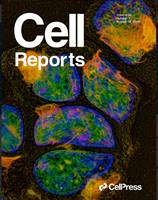 MD-PhD candidate, Adam Briner’s photo makes the journal cover of Cell Reports.
MD-PhD candidate, Adam Briner’s photo makes the journal cover of Cell Reports.
- Link to this issue: https://www.cell.com/cell-reports/issue?pii=S2211-1247(19)X0034-0
- Link to the Adam’s paper: https://www.cell.com/cell-reports/fulltext/S2211-1247(20)31030-5
Adam’s paper deals with the role of a kinase called Fyn in the development of tau pathology, which is one of the aggregated lesions in Alzheimer’s disease. He used a mouse model that lacks Fyn and found that tau aggregation was dramatically reduced, potentially highlighting the therapeutic value for Fyn inhibition in treating not only Alzheimer’s disease but all tau pathologies (which is a pretty big family of diseases). The cover image of the journal was a modified confocal microscopic image of a cellular model of tau aggregation (with aggregated tau in gold).
Read more about Adam’s PhD research:
While the underlying pathomechanisms of neurodegenerative disorders remain largely unknown, protein aggregation is a defining feature of all such dementias. Alzheimer’s disease, the most common form of dementia, displays extracellular aggregates of β-amyloid (Aβ) as amyloid plaques and neuronal neurofibrillary tangles (NFTs) made up of hyperphosphorylated tau protein. However, tau pathology alone is the causative element for a broad family of sporadic and hereditary dementias known as tauopathies.
A long held (albeit hotly contested) hypothesis in the field is that these two lesions work synergistically alongside a tyrosine kinase named Fyn to induce neuronal loss. However, whether Fyn controlled tau pathology in diseases that lack Aβ pathology remained unexplored. To address this gap, we generated a mouse model that couples Fyn knockout with tau pathology, which we named the Tg/Fyn-/-. To our great surprise, we found that the Tg/Fyn-/- mouse were virtually clear of NFTs, while displaying strong reductions in tau hyperphosphorylation, insoluble tau, and synaptic tau accumulation. The tau in the brains of Tg/Fyn-/- mice was also markedly limited in its prion-like activity. Lastly, we showed that this amelioration of tau aggregation was at least in part driven by Fyn’s direct phosphorylation of tau. Overall, these findings highlight the possible therapeutic value of Fyn-inhibiting drugs in treating not only Alzheimer’s disease but all dementias bearing tau pathology.
The cover image of the journal was a modified confocal microscopic image of a cellular model of tau aggregation (with aggregated tau in gold).



